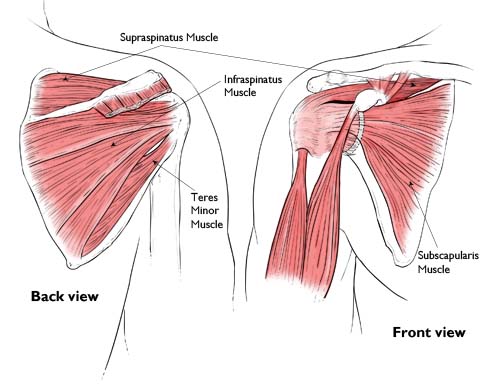The subscapularis is the largest of the four rotator cuff muscles. The subscapularis assists in stabilizing the humeral head during motion and works to assist with internal rotation (twisting in) of the arm during reaching, pulling and lifting activities. (For more detail, check out our prior posts on the rotator cuff). It sits between the front surface of the scapula and the back of the ribcage, so it is tough to palpate and self release - but not impossible!
When the subscapularis becomes tight, weak and/or dysfunctional, it can cause an array of problems:
- Loss of shoulder motion
- Pain in the shoulder (diffuse and sharp) with movement
- Weakness/loss of shoulder stability
- Referred pain in the neck, behind the shoulder blade, in the tricep/bicep, along the outside of the elbow, or down in the wrist and hand
Many trigger points/issues in this muscle occur at the musculotendonous junction (AKA where the muscle meets the rotator cuff tendon). Areas of tightness cause loss of muscular contractility and as such can artificially create weakness by preventing the normal physiological overlap and stretch of the muscle fibers on a microscopic level. These trigger points (or "knots") can also decrease circulation, change the brain's perception of the muscle's health and are neurologically driven (meaning that often stretching alone is not sufficient).
But - don't despair. You can reach some of these distal areas and help release them with a foam roll if you know what you're doing. Check out the video below:
Disclaimer:
For some, the tightness/issue is a "one-time thing" and foam-rolling several times will restore normal motion and alleviate pain (Yay!).
But for many of us with shoulder issues - this is not the "fix all" exercises and the tightness/pain seems to return again after activity. So - if this helps you alleviate the pain and restore motion BUT you seem to be doing it all the time to keep the symptoms from come back, there is likely another issue driving the subscapularis dysfunction. Rather than keep "managing" the issue with repetitive rolling, it's best to get to the route of the problem. As shoulder issues are complex and very individualized, a professional assessment by a skilled physical therapist is recommended.
References:
- Arendt-Nielsen L, Svensson P (2001). "Referred muscle pain: basic and clinical findings". Clin J Pain 17 (1): 11–9.
- Chris Littlewood, Stephen May and Stephen Walters, (2013) Systematic Reviews of the Effectiveness of Conservative Interventions for Rotator Cuff Tendinopathy, review.
- Kibler WB. The role of the scapula in athletic shoulder function. Am J Sports Med 1998; 26:325-337
- Mehta N. and George E. , Head, Face, and Neck Pain Science, Evaluation, and Management ; p. 534.
- Neumann DA. Kinesiology of the musculoskeletal system: Foundations for Physical Rehabilitation.2nd Ed. Elsevier Health Sciences; 2009


